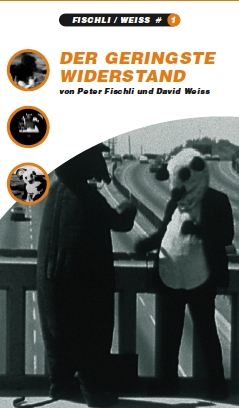«Is there work?» asks the bear. «No, money», answers the rat and in reply to the bear’s remark, «But, how?» the rat starts to wonder himself, «By … fraud? … In the art world … We’re gonna charge ruthless prices, just like the others. Only much better. Although, we don’t actually understand anything about it, but that will change … We’ll go on an educational trip.» The ‘educational trip’, which the two of them spontaneously, although with somewhat dubious motives, set out on, fulfils their ‘educational’ needs and they soon end up in the cool atmosphere of an elegant gallery where, unexpectedly, in the middle of ‘interesting’, modern sculptures, they find a dead body. The bear, whose idea of the art scene had, until then, been clear («… a sophisticated lifestyle, stylish and elegant, filled with friends, traveling, dancing, the theater and tennis»), becomes rather disconcerted once faced with this crime. The rat, on the other hand, realizes that this dead body could just be the very thing through which they might gain admittance to the world of beauty and elegance and confidently remarks, “We’ll be the center of attention of the jet-set. Together they move off to the jet-set, the rat with its somewhat unpleasant reputation as a rodent and its charming, plump body and a bear with its slightly slovenly elegance and smooth manners.” Irreverently, with an incongruous mixture of naivete and cocky shrewdness, the unlikely pair pitch into the false truths and true falsehoods of life in general and of the art scene in particular, in an attempt to get down to the root of the problem.
The utterances that the rat and the bear come out with are almost always on the boundary between infinite wisdom and total banality, always a trace of Socrates with an air of the local bar. At times their remarks just seem to flow, as though off an assembly line, like when the bear observes that it is not possible to be a great artist at the same time as being a detective and the rat acrobatically refuses to accept this idea:
«First of all, I am a great Romantic and secondly, they go perfectly well together. I believe in beauty and truth.
On the canvas of life the policeman is the brush. The law is the policeman’s good taste. An unsolved case is like an empty canvas.
To a policeman, his pistol is what an eraser is to an artist.» «Beauty and justice have nothing to do with each other. I have spoken. Never to be seen again, big mouth», is all the bear can answer, leaving the rat to his thoughts on truth and beauty. On the typewriter he spells out, «Beauty and truth, colon. Beauty is not always true and truth is not always beautiful, comma, unfortunately.» Inspired by an enthralling experience at the swimming pool of «rich artists», the rat and the bear eventually encounter their coveted beauty. A sexysounding female voice whispers to them, «I am cultivated life, elegance, you know me well, I am rapture and ecstasy, but also a good night’s rest and a lie-down. I am beauty and style, I am the time that is available, free beer in the neighborhood, I am champagne out of a lady’s shoe, I am the bowl that you eat from, I am the freedom with which you play, I am the least resistance.» Motivated by this voice, they now want to be artists themselves. However, their dream only comes ‘true’ in their imaginations, in an intoxicating, ‘in parts, non-representational’ torrent of their own and other pictures which fly towards them as they drive along Sunset Boulevard and which actually form the climax of the film. But their imaginations collide with harsh realities: the rat and the bear realize that their wishes will not be fulfilled in the degenerate art world and so their ‘educational trip’ ends with philosophical science, free of purpose and free of objects. Working concentratedly at their desks, they begin to understand the totality of creation and record their ideas in complex diagrams. Even when, shortly afterwards, in a surprisingly sharp turn of events, the two protagonists, who have tried their luck as artists, detectives and scientists, leave their lofty thoughts to return to the basics of money matters, here too there is banality as well as wisdom in their exalted intellectual airs, and more besides: what is said here is a concrete manifestation of the artistic work of David Weiss and Peter Fischli and of their projects in the Winterthur exhibition.
Patrick Frey
Reprinted by courtesy of the author, from Peter Fischli & David Weiss, pub ished by Patrick Frey, Munich and Dusseldorf, 1990, pp. 16-19
Translation: Joanna Nibler
© 2000 Kunstverlag Ingvild Goetz GmbH, Sammlung Goetz, Authors, Artists

Short feature film,
CH 1981, 30′, S-8 blow up 16mm
Directors
Peter Fischli, David Weiss
Original version: German
Production
Peter Fischli
David Weiss
T&C Film Zurich
Worldsales
T&C Edition Zurich




























































































































































